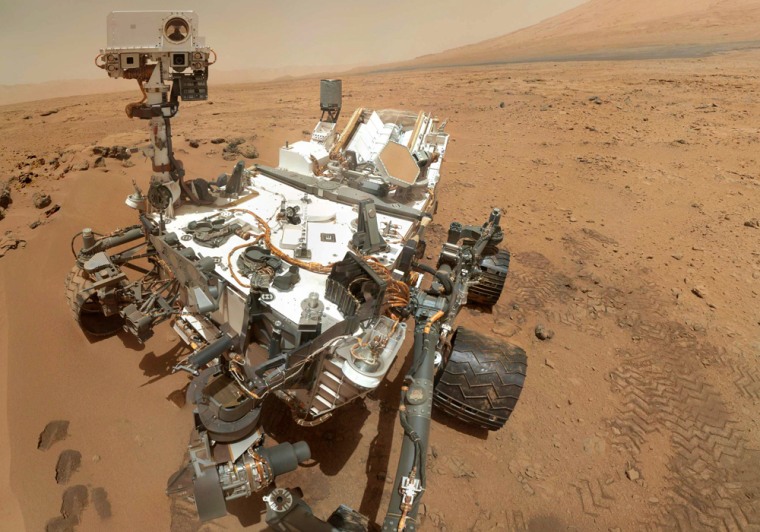The Curiosity rover's samplings of Mars' present-day atmosphere confirm the view that the planet lost most of its air early in its history — which implies there was only a relatively short time when the surface environment was hospitable for life as we know it.
"The last 2.5 to 3 billion years were probably pretty unfriendly to microbial life," said Paul Mahaffy, an atmospheric scientist at NASA's Goddard Space Flight Center, "But microbes are pretty adaptive to changing conditions. We don't know yet how they might have adapted to the currently harsh conditions on the surface of Mars."
Other findings from Mars probes, including Curiosity, suggest that the planet once had abundant water on its surface, perhaps including an enormous northern ocean. But the new results indicate that Mars has lost 90 percent of its atmospheric density since then, as part of its shift from life-friendly conditions to the current cold, dry climate.
Comparing past and present
The atmospheric loss was estimated by comparing present-day atmospheric readings with tiny bubbles of ancient Martian atmosphere contained in meteorites that were blasted away from the Red Planet and fell to Earth. One such meteorite, ALH 84001, was found in Antarctica almost 30 years ago and dates back 4 billion years — not long after Mars and the rest of the solar system took shape.
Scientists have done such atmospheric comparisons before — for example, using data from the Mars Viking probes in the 1970s. But the latest chemical measurements were made with unprecedented accuracy by two spectrometers in Curiosity's onboard lab, known as Sample Analysis at Mars, or SAM, Mahaffy led one of the teams, while the Jet Propulsion Laboratory's Chris Webster led the other team. Both teams' results were published in Friday's issue of the journal Science.
"Our results support the idea of a significant early loss a long time ago, and then a small loss over the last 3 to 4 billion years," Webster said in a Science podcast.
Heavy vs. light isotopes
The researchers reached that conclusion by measuring the proportions of isotopes for an assortment of elements. The various isotopes of a particular element are the same, chemically, but they differ due to the weight of their nuclei. For example, carbon-14 is heavier than carbon-12 because of two extra neutrons in the nucleus.
Over time, more of the lighter isotopes would have been lost from the Martian atmosphere, while more of the heavier isotopes remained. The comparison of ancient and modern readings provide "a window into the whole time history of Mars," Webster said.
The researchers on Webster's team plugged their readings into a computer model that wound back the clock on carbon, hydrogen and oxygen isotopes. Mahaffy's team focused on carbon dioxide, carbon monoxide, argon, nitrogen and oxygen. Both teams came up with a scenario for substantial atmospheric loss, early in Mars' history.
"Our results agree, so that's gratifying," Mahaffy said.
Questions remain
The results don't answer all the questions about Mars' lost atmosphere. Scientists surmise that the loss occurred because Mars lacks a protective magnetic field like Earth's, and that blasts of radiation from the solar wind and cosmic sources are continuing to strip away the atmosphere.
Mahaffy noted that Mars and other bodies in the solar system are thought to have taken a pummeling about 3.9 billion years ago from an asteroid storm known as the Late Heavy Bombardment, and that also may have played a role in Mars' atmospheric loss.
More answers are likely to come from NASA's Mars Atmosphere and Volatile Evolution orbiter, also known as Maven. The $670 million Maven mission is due for launch no earlier than Nov. 18, and will monitor Mars' atmospheric loss in real time starting in 2014.
In the meantime, the Curiosity rover will continue charting Mars' climate history by studying layers of Martian rock on the slopes of Mount Sharp, a 3-mile-high (5-kilometer-high) mountain in the middle of Gale Crater. It'll be up to future missions, such as the European-led ExoMars project and NASA's 2020 Mars rover, to look into whether past or present life could find a foothold on or beneath the surface of Mars.
More about Mars:
- Curiosity finds no methane on Mars ... yet
- Once, Mars had 'water you can drink'
- Radar reveals traces of huge Martian flood
- NBC News archive on Mars
In addition to Webster, the authors of "Isotope Ratios of H, C and O in CO2 and H2O of the Martian Atmosphere" include Mahaffy, Gregory Flesch, Paul Niles, John Jones, Laurie Leshin, Sushil Atreya, Jennifer Stern, Lance Christensen, Tobias Owen, Heather Franz, Robert Pepin, Andrew Steele and the MSL Science Team.
In addition to Mahaffy, the authors of "Abundance and Isotopic Composition of Gases in the Martian Atmosphere from the Curiosity Rover" include Webster, Atreya, Franz, Michael Wong, Pamela Conrad, Dan Harpold, Jones, Leshin, Heidi Manning, Owen, Pepin, Steven Squyres, Melissa Trainer and the MSL Science Team.
Alan Boyle is NBCNews.com's science editor. Connect with the Cosmic Log community by "liking" the NBC News Science Facebook page, following @b0yle on Twitter and adding the Cosmic Log page to your Google+ presence. To keep up with NBCNews.com's stories about science and space, sign up for the Tech & Science newsletter, delivered to your email in-box every weekday. You can also check out "The Case for Pluto," my book about the controversial dwarf planet and the search for new worlds.
